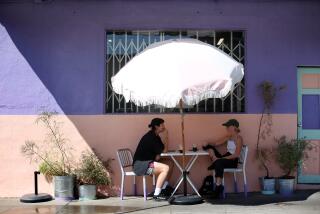Tribute to Tropicalia blends sound and sight
- Share via
The Brazilian Tropicalia movement lasted only a few years, roughly from 1967 through 1969. But its impact was powerful, opening the way for the stylistically inclusive MPB (Musica Popular Brasileira) genre that would dominate Brazilian music in the last decades of the 20th century.
On Saturday night, the transformative aspects of the brief Tropicalia era were celebrated at the Getty Museum’s Williams Auditorium in “Tropicalia ’68 -- Daring Days,” a fascinating presentation mixing video, live music, period recordings and dance. Performed nonstop, with songs flowing seamlessly from one to another, the program touched upon individual high points as well as the broad, genre-bending aspects of the movement.
The structure of the evening was both simple and imaginative. Grainy images from the period, interspersed with Joshua Light Show-like swirls of color and form, were projected onto a huge video screen. On one side of the stage, the ElectroTropic trio -- guitarist Kleber Jorge, keyboardist Bill Brendle and percussionist Meia Noite -- added their live supplementation to the playback of original recordings, mostly by the movement’s guiding lights, Caetano Veloso and Gilberto Gil.
The recorded songs included numerous classics -- including Gil’s “Domingo no Parque,” obviously inspired by the Beatles, and Veloso’s “Tropicalia” and “Proibido Proibir.”
From time to time, dancers came spinning out onto the stage: the Sundara Varna Tribal Fusion Bellydance ensemble (Monica Fernandez, Kaite Knecht and Ayse Cerami); flower girl Iliana Ramirez, the amazing Hula Hoop dancer Tisha Marina, and the vigorous samba dancing of the shapely, statuesque Paula Napole. Ricardo Cassettari added DJ touches, and Carmen Doane delivered colorful vocal renderings.
The hodgepodge of elements provided an illustration of Tropicalia’s all-inclusive philosophy -- reaching across the worlds of poetry, literature and film as well as music -- which reflected the desire to shake off the limitations of traditional art forms.
The production, by Sergio Mielniczenko, was an innovative and entertaining approach to the documenting of an important historical period. And it’s a method that could clearly be applied to other eras -- the folk music movement of the ‘60s, the dance music of the ‘70s, to mention only two possibilities.
More to Read
The biggest entertainment stories
Get our big stories about Hollywood, film, television, music, arts, culture and more right in your inbox as soon as they publish.
You may occasionally receive promotional content from the Los Angeles Times.










